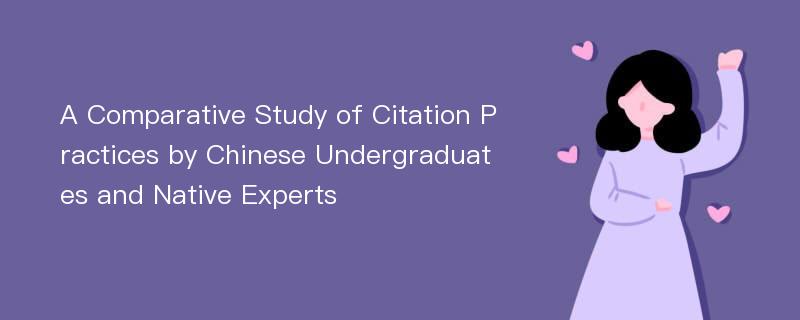
论文摘要
文内引用是学术写作的重要组成部分,恰当的引用能够提高学术写作的质量并展现作者对其研究领域的渊博知识。相反,不恰当的引用则会影响学术文章的表达,甚至被批判为抄袭。以往的引用研究表明,中国学生在文内引用行为上存在着较大的困难。因此,为了揭示学生的问题所在并为中国写作教学提供参考,本研究对比分析了中国英语专业大学生与英语本族语学者在引用使用上的异同,特别关注了两组在引用密度、引用年代、引用形式和引用功能上的异同。本研究分析了60篇学术文本。其中,30篇为英语专业语言学方向本科毕业论文;另外30篇为选自五本国际一流语言学期刊的文章,其作者均为英语本族语者或在英语国家接受教育并在高校任教的学者。此外,本研究还采访了6名英语专业本科毕业生。结合文本分析与访谈数据,本研究发现英语本族语学者在文内引用的使用数目和使用密度上均大大高于英语专业学生。在引用年代上,学生使用了更多的旧文献引用(超过15年),而学者则更偏向于引用发表于5年以内的新文献。另外,对于引用形式的选择,本族语学者倾向于使用非融入性引用形式,即把被引用作者的名字及出版信息作为附属信息放于句子后面的括号中,而学生偏向于使用融入性引用形式,即将被引用作者名字作为主语、宾语或名词短语置于句子中,这种形式在一定程度上影响了文本的整体流畅性。在引用功能上,引源指引是两组作者使用最多的引用功能;而在引论支持,文献参考,文献比较及论证例举几个功能的使用上,本族语学者的使用显著多于学生。本研究既有理论意义也提供了教学启示。在理论层面,本研究建立了一个专门针对语言学文本的新的引用功能分类框架,为未来的引用研究提供了新的视野。在教学层面,研究结果揭示了中国学生在引用中的问题及不足,指出教师和学生必须提高对引用的认识和重视。学生应该主动积累必要的引用句型及词汇并通过阅读专家学者的学术论文学习引用规范,而写作教师也应该在引用的表达方式和修辞功能等方面给予学生更多详尽细致的指导。
论文目录
ACKNOWLEDGEMENTS摘要ABSTRACTChapter One INTRODUCTION1.1 Need For The Study1.2 Overview Of The ThesisChapter Two LITERATURE REVIEW2.1 Definitions Of Citation2.1.1 Literal-Descriptive approach2.1.2 Functional approach2.1.3 Combined approach2.2 Theoretical Background2.2.1 History of citation studies2.2.2 Typologies of citation2.2.2.1 Content-based typologies2.2.2.1.1 Typologies based on citation features2.2.2.1.2 Typologies based on citation functions2.2.2.2 Typologies based on formal/syntactic criteria2.2.2.3 Typologies based on citer motivations2.3 Empirical Studies on Citation2.3.1 Citations in publishe/expert writings2.3.2 Citations in student writings2.3.3 Comparison of citation practices by student and expert writers2.4 Significance Of The StudyChapter Three METHODOLOGY3.1 Research Questions3.2 Research Data3.2.1 Textual data3.2.1.1 BA theses by Chinese undergraduates3.2.1.2 Research articles by native expert writers3.2.2 Interview data3.3 Data Collection3.3.1 Collection of textual data3.3.2 Collection of interview data3.4 Data Analysis3.4.1 Analysis of textual data3.4.1.1 Identification and counting of citations3.4.1.2 Categorization of citation age3.4.1.3 Categorization of citation forms3.4.1.4 Categorization of citation functions3.4.1.5 Comparative analysis3.4.2 Analysis of the interview dataChapter Four RESULTS AND DISCUSSION4.1 Surface Features Of Citation4.1.1 Citation number and density4.1.2 Citation Age4.2 Citation Forms4.2.1 Quantitative analysis4.2.2 Qualitative analysis4.2.2.1 Difference in the use of non-citations4.2.2.2 Difference in the use of nominal expressions4.2.2.3 Difference in sentence structure4.2.2.4 Difference in the choices of reporting verbs4.3 Citation Functions4.3.1 Quantitative analysis4.3.2 Qualitative analysisChapter Five CONCLUSION5.1 Major Findings5.2 Implications5.3 Limitations5.4 Suggestions For Future ResearchREFERENCESAPPENDICESAppendix 1 Information of students' BA thesesAppendix 2 Information of experts' research articlesAppendix 3 The Chinese version of the Interview Guide
相关论文文献
标签:文内引用论文; 引用密度论文; 引用年龄论文; 引用形式论文; 引用功能论文;
A Comparative Study of Citation Practices by Chinese Undergraduates and Native Experts
下载Doc文档
